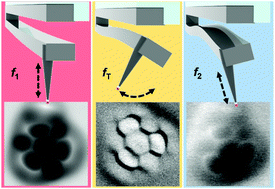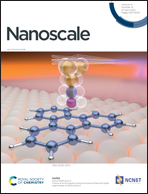Chemical bond imaging using torsional and flexural higher eigenmodes of qPlus sensors†
Abstract
Non-contact atomic force microscopy (AFM) with CO-functionalized tips allows visualization of the chemical structure of adsorbed molecules and identify individual inter- and intramolecular bonds. This technique enables in-depth studies of on-surface reactions and self-assembly processes. Herein, we analyze the suitability of qPlus sensors, which are commonly used for such studies, for the application of modern multifrequency AFM techniques. Two different qPlus sensors were tested for submolecular resolution imaging via actuating torsional and flexural higher eigenmodes and via bimodal AFM. The torsional eigenmode of one of our sensors is perfectly suited for performing lateral force microscopy (LFM) with single bond resolution. The obtained LFM images agree well with images from the literature, which were scanned with customized qPlus sensors that were specifically designed for LFM. The advantage of using a torsional eigenmode is that the same molecule can be imaged either with a vertically or laterally oscillating tip without replacing the sensor simply by actuating a different eigenmode. Submolecular resolution is also achieved by actuating the 2nd flexural eigenmode of our second sensor. In this case, we observe particular contrast features that only appear in the AFM images of the 2nd flexural eigenmode but not for the fundamental eigenmode. With complementary laser Doppler vibrometry measurements and AFM simulations we can rationalize that these contrast features are caused by a diagonal (i.e. in-phase vertical and lateral) oscillation of the AFM tip.



 Please wait while we load your content...
Please wait while we load your content...